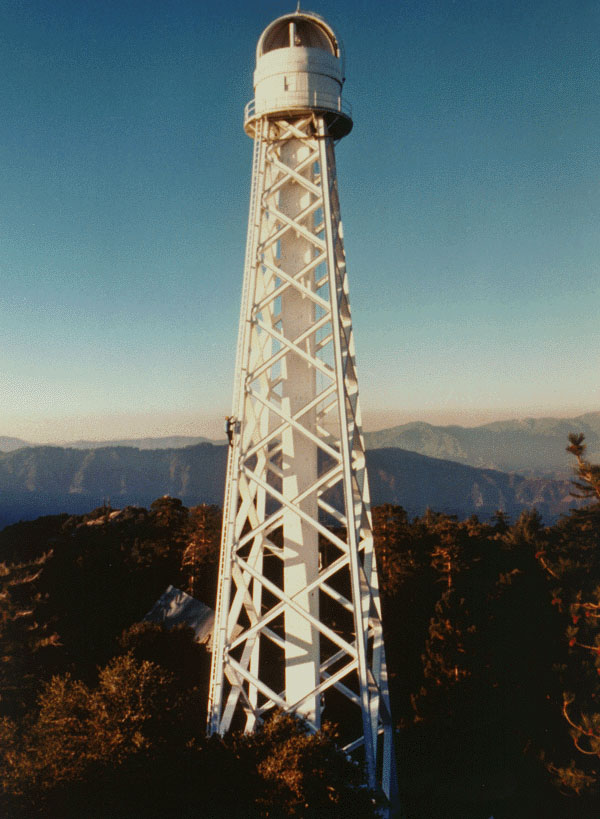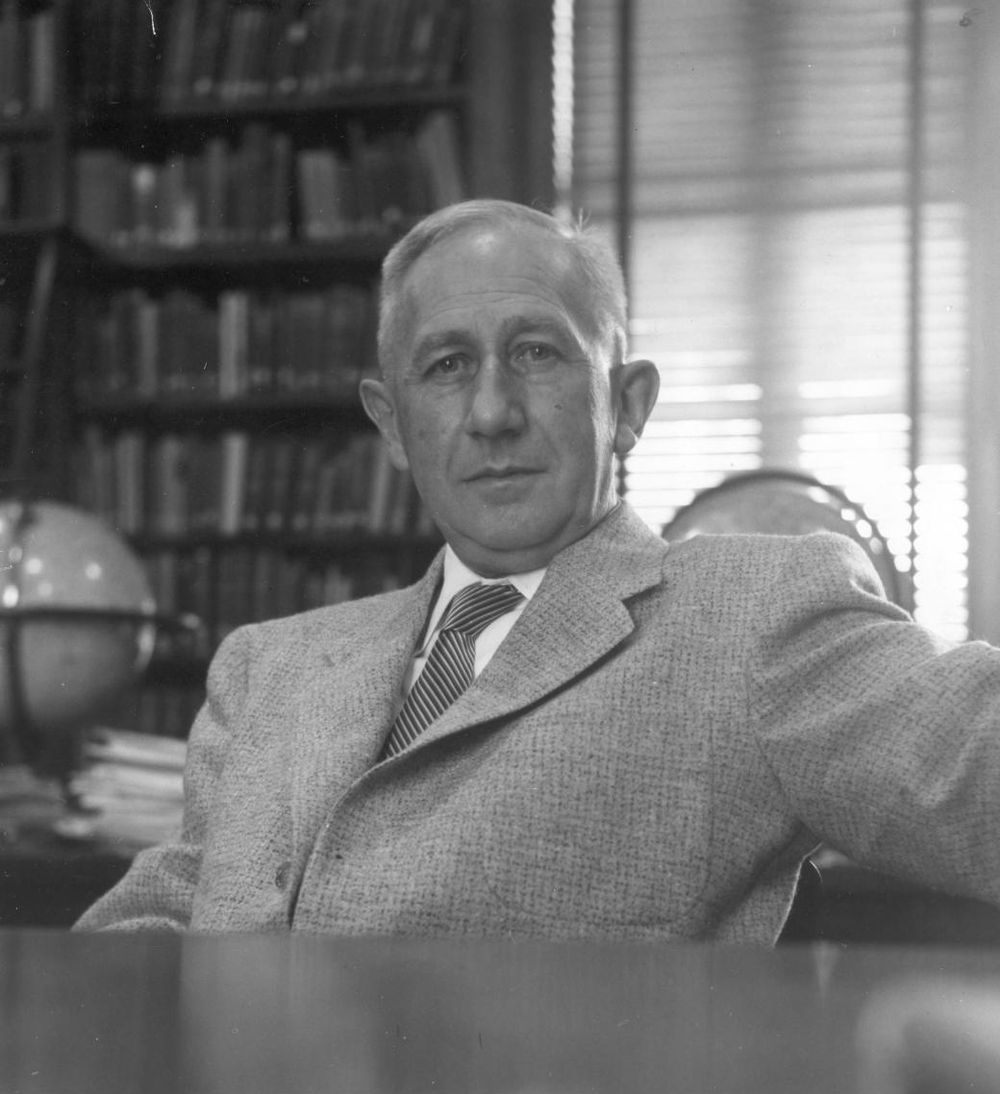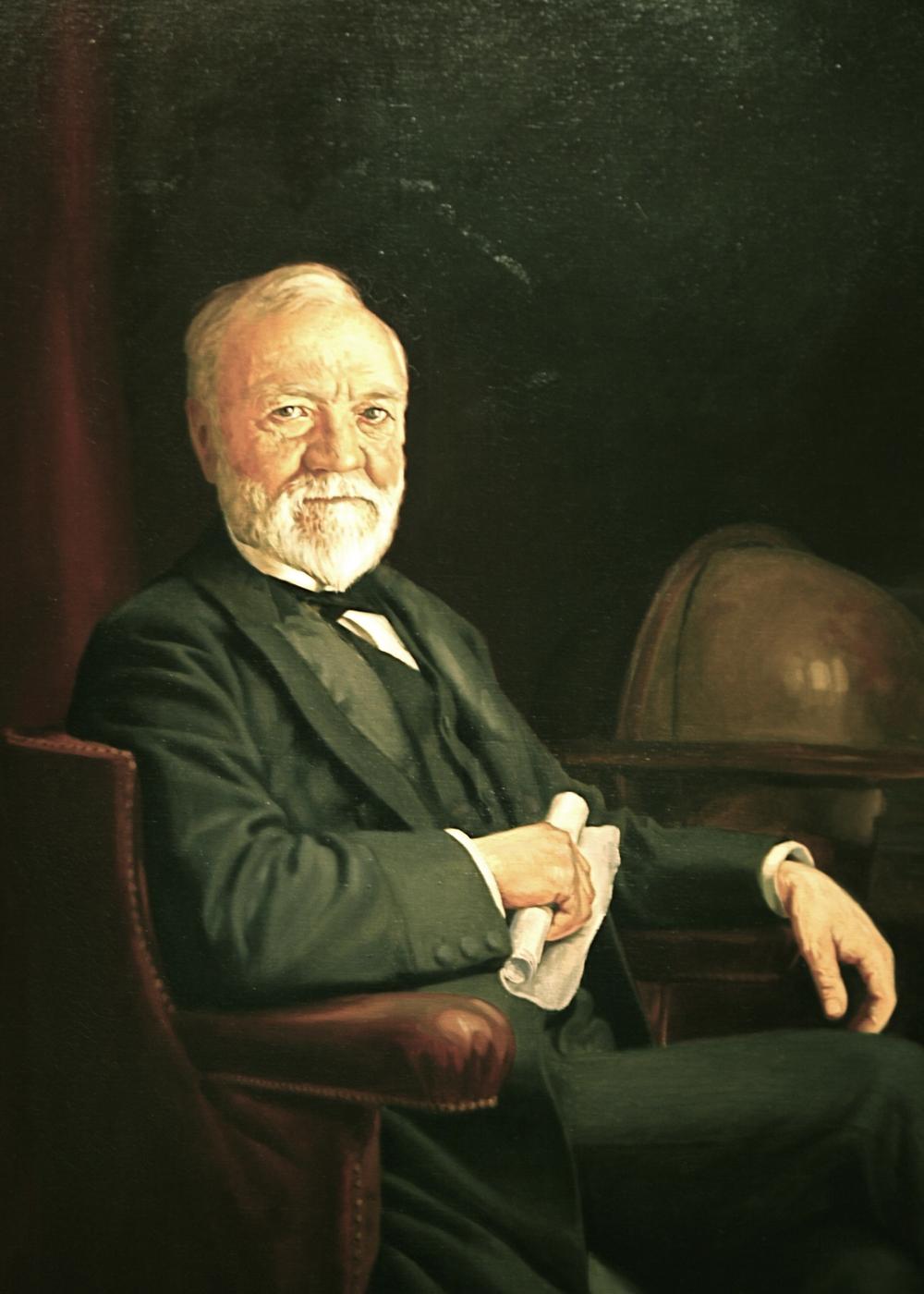
Category of Astronomical Heritage: tangible immovable
Mount Wilson Observatory, USA

Description
Geographical position
Mount Wilson Observatory, San Gabriel Mountains near Pasadena, California CA
See also: Observatories connected to George Ellery Hale:
- Kenwood Astrophysical Observatory, Chicago
- Yerkes Observatory (1897)
- Mount Wilson Observatory (1904)
- Palomar Observatory (1928/1948)
- Hale Solar Laboratory, Pasadena (1923)
Location
Latitude 34°13'29'' N, Longitude 118°03'27'' W, Elevation 1741m above mean sea level.
IAU observatory code
672
Description of (scientific/cultural/natural) heritage
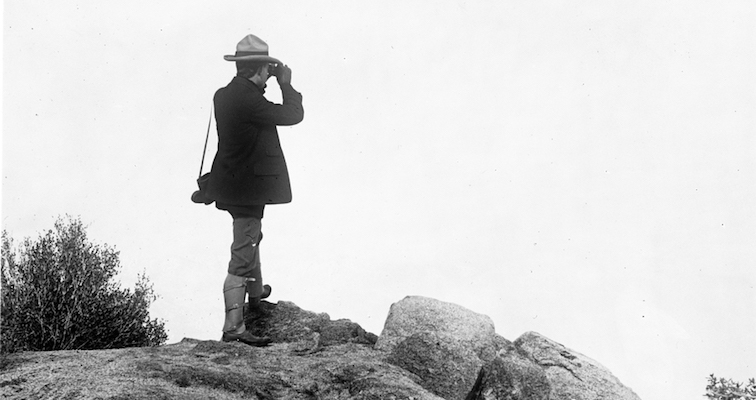
Fig. 1a. George Ellery Hale (1868--1938) atop Mount Wilson with binoculars (1903), looking for the site for the new observatory (Carnegie Huntington Library)

Fig. 1b. Mount Wilson Solar Observatory (1904), (CC)
The Mount Wilson Solar Observatory (1741m) was founded by George Ellery Hale (1868--1938) in 1904 - seeking clearer skies than existed near his native city Chicago. He soon found Andrew Carnegie (1835--1919) as generous sponsor for his ideas.
Hale wanted to understand the internal physics of the Sun and the stars. Mount Wilson is the home of some of the most important telescopes in the development of modern astronomy for photographing and studying stars and "nebulae" (galaxies) in an expanding Universe.
The "headquarters" of the Mount Wilson Observatory, with its optical workshop and administration, was established in Pasadena, 13 km northeast of Los Angeles.
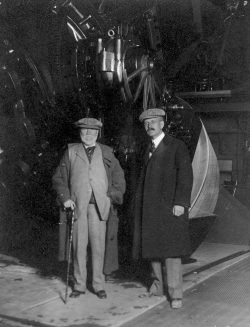
Fig. 2a. Andrew Carnegie (1835--1919) and George Ellery Hale (1868--1938) in 1910 (Mount Wilson Archives)

Fig. 2b. Carnegie's philanthropy (Puck magazine cartoon Louis Dalrymple, 1903, CC)
Solar Physics in Mount Wilson Observatory
Hale, as a member of the Executive Committee and Advisory Committee of the Carnegie Institution of Washington for the field of astronomy, looked for a suitable observation site for a new observatory in 1903. First, the Snow Telescope, funded by a donation of 10,000 dollars from Helen E. Snow (*1838) of Chicago in memory of her father George Washington Snow (1797--1870), was moved here to the much better climatic conditions.
In 1904, with the generous support of the Carnegie Foundation, the mountain observatory "Mount Wilson Solar Observatory" was built near Pasadena with two tower telescopes, erected in 1907 and 1912, and the 60-inch and 100-inch reflecting telescope (1908 and 1917). The 100-inch Hooker was the largest aperture telescope in the world until 1948.

Fig. 3a. Snow Telescope house on Mount Wilson Solar Observatory (CC)

Fig. 3b. Coelostat and second mirror of the Snow Telescope (CC)
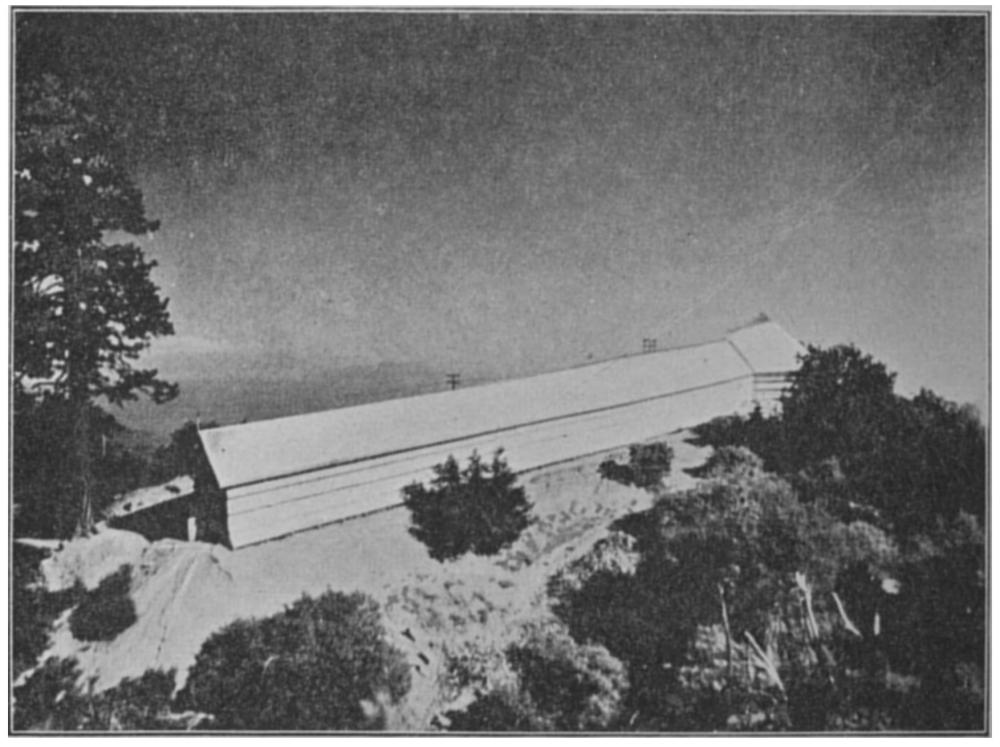
Fig. 3c. Long shed of the Snow Horizontal Telescope on Mount Wilson Solar Observatory (CC)
The Snow Horizontal Solar Telescope was designed in 1903 by George W. Ritchey (1864--1945). In 1905, Hale started his research with the Snow Telescope, which he brought in 1904 from Yerkes Observatory to the sunny skies of Mount Wilson Solar Observatory (the word "Solar" for the observatory name was dropped in 1919, when the 100-inch Hooker Telescope appeared).
The wooden house with a canvas-covered roof was later replaced by sheet iron and a steel roof. The Snow Telescope has a 30-inch (76cm) coelostat-fed 24-inch (60cm) primary paraboloidal mirror (f/30) for photographing the Sun's disk, the sunspots and prominences. With the Snow telescope it could be discovered that sunspots have a lower temperature than the solar photosphere, in addition evidence was found that sunspots are associated with a magnetic field.
In 1919, a subterranean, high-resolution diffraction-grating Littrow spectrograph was added. After World War II, a major boost happened [Laderman 2023] with a new generation of infrared detectors (lead sulfide PbS). For IR, more infrared energy would be transmitted than would pass through lenses -- as a result, carbon monoxide (CO) molecules were found in the solar atmosphere in 1951 [Goldberg et al. 1952].

Fig. 4a. 150-foot (46m) Solar Tower (1912) (UCLA)

Fig. 4b. 150-foot (46m) Solar Tower (1912) (CC3, Davefoc)

Fig. 4c. Hale solar spectrograph of the 60-foot solar tower (MWO)

Fig. 4d. Dome of the 150-foot (46m) Solar Tower (CC3, Davefoc)
Due to the experiences with distorting effects, heating of the mirrors near the ground, Hale decided to erect two vertical solar telescopes with 12-inch lenses as primary focusing elements: a 60-foot (18m) Solar Tower (1907) and 150-foot (46m) Solar Tower (1912), operated by the Division of Astronomy and Astrophysics at UCLA. A dome was added to the 150-foot Tower in 1914. The construction consists of two towers, one within the other, in order to get a steady image. A first 12-inch (f/150) lens, a triplet apochromat lens was grounded by Brashear (1910), a second doublet achromat lens (1911); in 1971, replaced by a Perkin-Elmer cemented triplet apochromat. A 75-foot spectrograph with a grating obtained from Albert Michelson and a Littrow lens from John Brashear was added in 1912.

Fig. 4e. Magnetically induced Zeeman splitting in the spectrum of a sunspot (NCAR)

Fig. 4f. Hale Polarity Law (NCAR)

Fig. 4e. Magnetogram, Dopplergram, Intensitygram (8. Nov. 2011), 150-ft solar tower Mount Wilson (MWO)
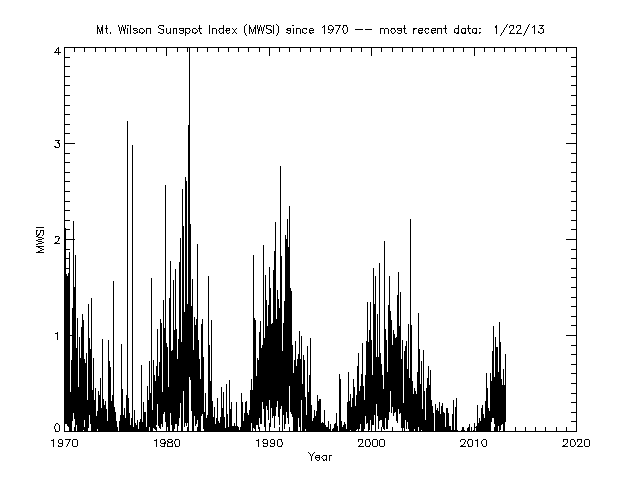
Fig. 4f. Sunspot Index Plots (MWSI) since 1970, Mount Wilson (MWO)
The solar towers proved successful in conjunction with the spectroheliograph invented by Hale and also for measuring magnetic fields. With the help of two mirrors (coelostats), the Sun's light is directed into the tower, in which there is the spectrograph deep down.
In 1908, Hale recorded the splitting in the spectrum of a sunspot, showing for the first time that sunspots have strong magnetic fields, some 1000 times stronger than the Earth's magnetic field. They have field strengths of up to 3000 Gauss -- for comparison: the earth's magnetic field has a strength of 0.5 Gauss (1000 Gauss = 1 Tesla). The splitting was due to the Zeeman effect, which was discovered in 1896 by Pieter Zeeman (1865--1943): A strong magnetic field splits spectral lines into two or three components. The stronger the magnetic field, the greater the splitting: For example, a splitting of certain spectral lines of 0.2 Å indicates a magnetic field of 4000 Gauss.
In the sun's "magnetogram" magnetic fields of northern polarity and southern polarity can be distinguished. In 1912, Hale observed the reversal of the polarity in sunspots in a new solar cycle. After 11 years, the magnetic field reverses, both in the sunspots and the overall field, as Hale discovered in 1914 -- therefore, the entire sunspot cycle lasts even 22 years, called "Hale cycle".
In 1911, Walter Sydney Adams (1876--1956) studied accurately the spectroscopic rotation; this velocity field is now called supergranulation. This work was continued by Charles Edward St. John (1857--1935)) in the 1920s and 1930s. He tried to measure the gravitational redshift of the Sun. Edison Pettit (1889--1962) studied solar proninences and flares the K-line of Ca II, already recorded on 35-mm-film.
With the 150-foot Solar Tower, Hale wanted to measure the general magnetic field of the Sun; it is now known not to exist.
Harold Delos Babcock (1882--1968) together with his son Horace Welcome Babcock (1912--2003) developed the modern magnetograph (1951) for measuring strong magnetic fields, also in stars. In 1959, they recognized the periodic polarity reversal of the solar magnetic field. H.W. Babcock also paved the way in 1953 for Adaptive Optics.

Fig. 4g. Walter Sydney Adams (1876--1956) (MWO)

Fig. 4h. Robert Benjamin Leighton (1919--1997) (USC)

Fig. 4i. Horace Welcome Babcock (1912--2003) (UCLA)
In the 1960s, Robert Benjamin Leighton (1919--1997) developed modern Doppler shift and Zeeman effect solar cameras for the study of magnetic and velocity fields on the Sun. With the Zeeman camera, he made the spectacular discovery that the Sun had a 5-minute oscillation and the new field of helioseismology was born, and in addition the dynamo model of the solar cycle.
Mount Wilson as the first modern solar observatory in the World became a model for many others in the 20th century (cf. Einstein Tower in Potsdam Astrophysical Observatory, 1924). Until the completion of the McMath Telescope at KittPeak, the 150-foot (46m) Solar Tower (1912) was the largest focal length solar telescope in the world.

Fig. 5a. 60-inch-telescope on a truck for the transport from Pasadena to Mount Wilson Observatory (Carnegie / Huntington Library)

Fig. 5b. 60-inch Reflecting Telescope (1908), (photo: Dave Jurasevic)
Reflecting Telescopes in Mount Wilson Observatory
Soon after completing the Yerkes Observatory in southern Wisconsin in 1897, George Ellery Hale realized that his Yerkes 1-m-Refractor could never be surpassed.
The master optician George W. Ritchey (1864--1945) made a 60-cm reflector for comparison, and Hale began to rely more on this type of telescope and made great efforts with the development of reflecting telescopes.
In addition, he was looking for an even more favorable location for astrophysical research. Above all, he had to find another sponsor. Eventually, Hale received a large sum from the Carnegie Institution in Washington and was able to move his activities to sunny California.
George Ellery Hale, director from 1904 to 1923, started his next project, the 60-inch (1.50m) Reflecting Telescope - the largest telescope in the world from 1908 to 1917 - and was the world's first very successful large reflecting telescope with a glass mirror. This was a major re-invention of the astronomical telescope, setting the standards by which all major astronomical telescopeshave been built since. The 60-inch was designed for photography and spectroscopy. It was the first large telescope with an interchangable secondary mirror, and the first with a Coudé focus, for high resolution spectroscopy.

Fig. 5c. Transport of the 100-inch-mirror of the Hooker Reflecting Telescope (1917), (CC)
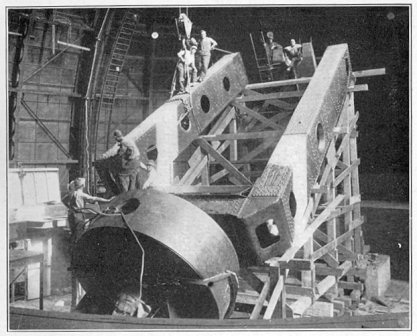
Fig. 5d. 100-inch Hooker, assembling the polar axis (CC)

Fig. 5e. 100-inch Hooker Reflecting Telescope (1917), (Carnegie)

Fig. 5f. 100-inch Hooker Reflecting Telescope (1917) (photo: Dave Jurasevic)
Finally as a highlight, the Hooker 100-inch (2.50m) Reflecting Telescope was built by Ritchey in 1917, donated by John Daggett Hooker (1838--1911), vice-president of the Baker Iron Works, the company that built the first locomotive constructed in Los Angeles, and president of the Western Union Oil Company. In addition, he was also an amateur astronomer, and a founder of the California Academy of Sciences.
Hale employed the two outstanding astrophysicists Harlow Shapley (1885--1972) and Edwin Powell Hubble (1889--1953) immediately after their doctoral studies and also promoted research in the rising field of galactic and extragalactic astronomy. The staff included also such famous astronomers like Milton Humason, Walter Baade, Fritz Zwicky, and Allan Sandage.
As the next and final step, Hale in cooperation with Mount Wilson astronomers and the Carnegie Institute of Technology planned a 5-m (200-inch) reflecting telescope for Palomar Mount (Palomar Observatory) with funds from the Rockefeller Foundation. This led to the institution Mount Wilson and Palomar Observatories, Carnegie Institution of Washington, California Institute of Technology (the partnership lasted until 1980). But Palomar Observatory was not completed until 1948 - ten years after Hale's death - and the 5-m (200-inch) reflecting telescope was named after him as "Hale Telescope".

Fig. 6a. George Ellery Hale (1868--1938), (CC)

Fig. 6b. Albert Einstein with Edwin Powell Hubble (1889--1953), Walter Adams at the Hooker Telescope (1931), (Caltech Image Archives)

Fig. 6c. Edwin Powell Hubble (1889--1953) observing at the Hooker Telescope (Carnegie Archives)

Fig. 6d. Hubble's famous M31 VAR! glass plate: letter N was crossed out and is marked "VAR!" (H335H, October 6, 1923); this was the first discovery of a Cepheid outside our Milky Way (Carnegie Archives)

Fig. 6e. Edwin Powell Hubble (1889--1953), Johan Hagemeyer (1884--1962), (CC)
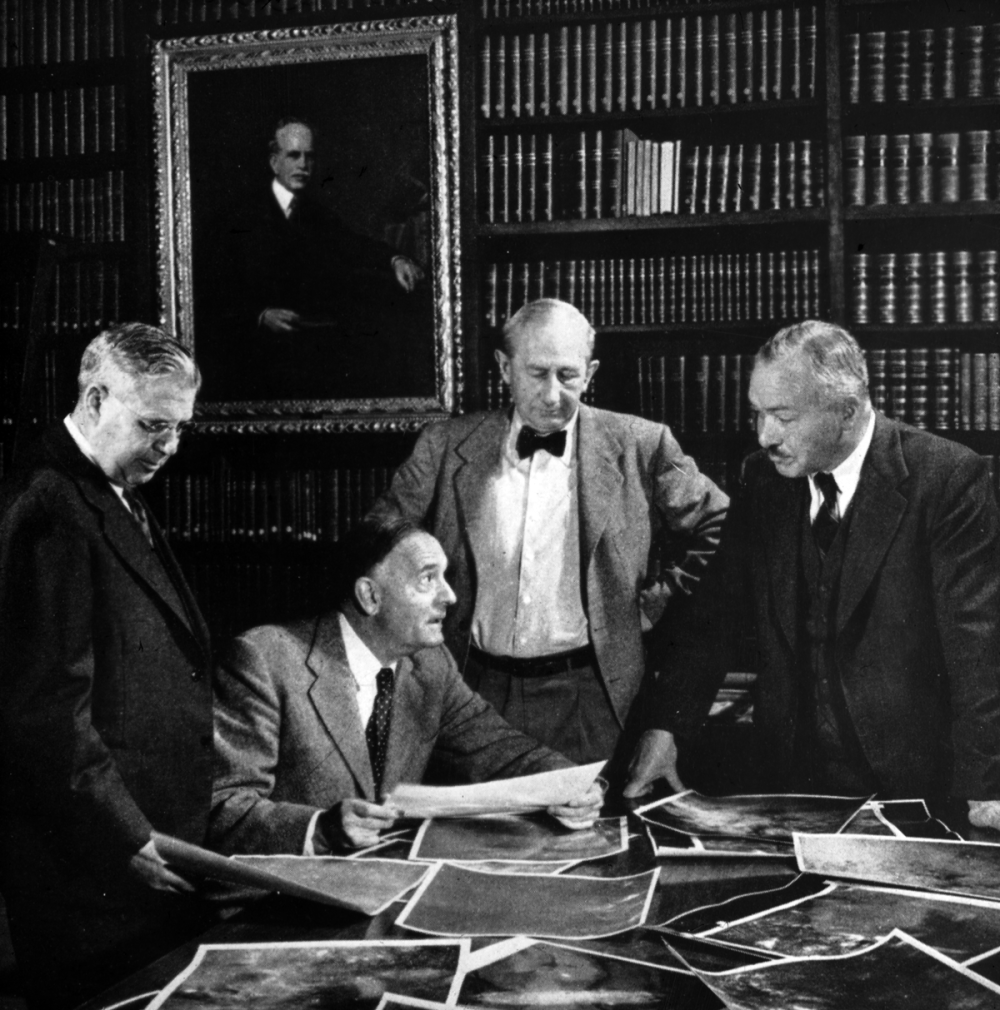
Fig. 6f. Humason, Hubble, Baade and Minkowski, at the wall the portrait of Hale (Hamburg Observatory Archives)

Fig. 6g. Staff and women computers in front of Pasadena office building (MWO)
Highlights in Mount Wilson Research
(cf. link, Mount Wilson Astronomers & Staff, Women computers)
- Sunspots have strong magnetic fields, some 1,000 times stronger than the Earth's magnetic field. Hale could measure them with the Zeeman effect; they have field strengths of up to 3000 Gauss.
- Looking at the Sun's "magnetogram", magnetic fields of northern polarity and southern polarity can be distinguished with a reversal every 11 years. Therefore the entire sunspot cycle lasts 22 years, discovered by Hale in 1924.
- After Henrietta Swan Leavitt (1856--1921) at Harvard Observatory had studied Cepheids in the Small Magellanic Cloud, she found that bright Cepheids have longer periods, i.e., that they pulsate more slowly: There was a linear relation between period and apparent magnitude.
In 1915, Harlow Shapley (1885--1972) at Mount Wilson tried to improve the gauging method of Ejnar Hertzsprung (1873--1967), 1913. He investigated the same 13 galactic Cepheids, and got a distance for the Small and Large Magellanic Cloud (LMC) of 102,000 or 112,000 light years respectively. His first results corresponded to dimensions of the Milky Way of 30,000 light years -- a value which was accepted at that time, and determined by Jacobus C. Kapteyn (1851--1922) of Groningen. But in 1917, Shapley determined distances of more globular clusters and also got large values of 27,000 to 200,000 light years. Then his ideas started to change radically: the diameter of the Milky Way is 300,000 light years -- ten times larger than supposed at that time (Big Galaxy model).
Heber Doust Curtis (1872--1942) relied on the measurement of distance by the nova method. After inspecting photographic plates of Mount Wilson, he looked at Lick Observatory plates. In 1917, Curtis got the distance of the Andromeda nebula of about 500,000 light years and ten millions or more light years for other distant spirals. With these results the extragalactic character of the Andromeda nebula should be clear but some astronomers, especially Shapley, doubted.
This controversy was discussed in the Great Debate "The Scale of the Universe", initiated by Hale. It took place in the National Academy of Sciences in Washington April 26, 1920. Curtis didn't regarded the spiral nebulae as objects of our Milky Way
but as distant stellar systems comparable to our Galaxy. The controversial topic was Shapley's size of the Milky Way with 300,000 light years, which contradicted to Curtis' idea with 30,000 light years. - Based on Slipher's measured large redshifts in the spectra of spiral nebulae, that means high radial velocities (e.g. 300 km/s for the Andromeda nebula, 1912), Edwin Powell Hubble (1889--1953) continued this research in the 1920s, assisted by Milton Humason (1891--1972). Hubble made decisive progress in clarifying the structure of the cosmos in three steps:
- an improved determination of the distances of nebulae: he found more novae in "galaxies". Then the spectacular discovery --
the M31 VAR! glass plate: the letter N was crossed out and is marked "VAR!" (H335H, October 6, 1923); this was the first discovery of a Cepheid outside our Milky Way. Now you could get the distance of the Andromeda nebula M31 (827.000 light years, 1924) by the accepted Cepheid method, confirming the results of the Nova method.
"Dr. Hubble, working with the 100-inch Mount Wilson reflector, had succeeded in resolving portions of two of the spiral nebulae, those of Andromeda and Triangulum, into seperate stars, and from a study of the period-luminosity curves of the Cepheid variables in the nebulae had derived distances approaching one million light years for each, thus bringing confirmation to the so-called island universe theory."
Thirty-Third Meeting of the American Astronomical Society at Washington, Dec. 30, 1924 -- Jan. 1, 1925, held with the American Association for the Advancement of Science. In: Publications of the American Astronomical Society 5 (1927), p. 245--248, here p. 246 (Popular Astronomy 33 (1925), here p. 159). - the classification of "nebulae" (tuning-fork diagramme: Elliptical, Spiral, Lenticular galaxies), introduction of the word "Galaxies" for extragalactic nebulae (1926)
- the discovery of the velocity-distance relation (1929):
Hubble measured more large redshifts of galaxies -- high radial velocities. He discovered that the redshift increases with distance, showing that the galaxies are moving away from us -- that they could be interpreted as a hint to the expanding universe. 46 galaxies led to a value for the Hubble constant of 500 km/s/Mpc [Hubble 1936] (much higher than the currently accepted values of about 70 km/s/Mpc).
- an improved determination of the distances of nebulae: he found more novae in "galaxies". Then the spectacular discovery --
- Walter Baade (1893--1960) discovered that δ Cephei star can have different luminosities, and introduced the phenomenon of stellar populations:
1. the classic Cepheids (luminous hot blue stars in spiral arms - disk population or "Population I") and 2. the short-period RR Lyrae stars - on red-sensitive photographic plates - with a different "period luminosity relationship" (red stars in globular clusters or in elliptical galaxies - "Population II" Cepheids).
Baade's physical explanation, according to which the relation between period and luminosity depends on metal abundance ("Metals" in astrophysics are all elements heavier than hydrogen and helium) of the star depends (blue stars population I are metal-rich and younger, red stars of population II are metal-poor and older), changed thet understanding of the evolution and the age of the galaxy (color-brightness diagramme).
Thus, Baade corrected Hubble's result for the distance of M31 to be nearly 900,000 light years (1924) to about two million light years. This meant that consistent values for the diameter of our galaxy with 100,000 light years and the distances of galaxies were achieved. In 1952, Baade presented at the General Assembly of the International Astronomical Union in Rome the spectacular result of doubling the size and thus the age of the universe. [Wolfschmidt 2022]. - Rudolph Minkowski (1895--1976) was particularly interested with the detection and study of planetary nebulae, novae and supernovae. The classification of supernovae (together with Walter Baade) into types I and II, based on their spectral characteristics, made a significant contribution to astronomical distance determination. Minkowski and Baade also found optical counterparts to various radio sources. [Minkowski 1958].
- Harlow Shapley (1885--1972) mapped the globular cluster system of our galaxy.
- Adams, Joy, Sandage, and others established the empirical basis for theories of stellar structure and evolution.
- Ira Sprague Bowen (1898--1973) discovered in 1927 that the green emission line for "Nebulium", found in the gaseous Cat's Eye Nebula at 4959 and 5007 Å by William Huggins in 1864, was no new chemical element but instead doubly ionized oxygen.

Fig. 7a. 20-foot Stellar Interferometer attached to the 100-inch-Hooker telescope (1920), (CC)

Fig. 7b. 50-ft Stellar Interferometer, Francis G. Pease (1881--1938) observing at Mount Wilson (1930), (Caltech Archives)

Fig. 7c. CHARA Interferometer array -- one of six telescopes (CC3, Davefoc)

Fig. 7d. Measuring the diameters of stars -- HRD Diagramme (CHARA)

Fig. 7e. Rapid Rotators (CHARA)

Fig. 7f. The eclipsing binary β Lyrae (CC0, CHARA)
Stellar Interferometry
Stellar Interferometry started in Mount Wilson Observatory:
The 20-foot (6m) stellar interferometer, developed by Albert Abraham Michelson (1852--1931) and Francis Gladheim Pease (1881--1938), was mounted at the top of the 100-inch Hooker telescope (1919). They succeeded to measure the angular diameter of the red giant Beteigeuze. Their result (0.047'') was very close to the value, estimated by 0.047" Arthur Stanley Eddington (1882--1944). The interferometer was also used for the separations of binary systems.
The experiments were continued by Pease with a 50-foot (15m) stellar Interferometer for measuring more stellar diameters.
The measuring principle of interferometry was not only the basis for CHARA, but also for the Very Large Telescope (VLT), U.S. Navy's Navy Precision Optical Interferometer (NPOI) at the Anderson Mesa Station of Lowell Observatory, and for the detection of gravitational waves.
A groundbreaking new Stellar Interferometry consisting of array consists of six 1-m (40-inch) telescopes started on Mount Wilson owned by Georgia State University (GSU): Center for High Angular Resolution Astronomy (CHARA) is the world's largest optical interferometric array, supported from the National Science Foundation (NSF), started in 1984, completed in 2003. (www.chara.gsu.edu/CHARA). The resolving power of the array equals to a telescope with a 330-m-mirror, and an angular resolution of 200 micro-arcseconds.
- An exoplanet, HD 189733b could be measured directly (2007)
- Measuring Stellar Diameters (2012)
- Spotted Magnetic Stars: Starspots on Zeta Andromedae, a star 181 light years away, could be shown (2013)
- Eclipsing Binaries: A fascinating direct observation of interacting and eclipsing binary systems, such as β Lyrae and Algol (2008, 2012)
- Rapid Rotators, Be Stars: directly imaging of stars like Regulus, Rasalhague, Altair, Alderamin and β Cassiopeiae, showing the flattened shape of rapidly rotating stars, showing the effect of gravity darkening (2020)
- Nova Explosions, Nova Delphinus 2013 (V339 Del)
- CHARA can resolve the circumstellar disks around Be-stars (2020)

Fig. 8. George Ellery Hale (1868--1938) at his desk, Monastery Mount Wilson (1905), (MWO)
George Ellery Hale as a science organizer
As an international leader in solar physics, Hale advocated professionalization and improved the organizational structure of solar and astrophysics through the founding of the International Solar Union (ISU 1904) -- in conjunction with the St. Louis World's Fair -- and journals (Astrophysical Journal -- "an International Review of Spectroscopy and Astronomical Physics", ApJ 1896); James E. Keeler (1857--1900) was the co-editor. It is still the leading Astrophysical Journal in the world today.
As a science organizer, he also founded the American Astronomical (and Astrophysical) Society in 1898, later the California Institute of Technology, which emerged from the then relatively unknown Throop Polytechnical Institute in Pasadena.
Hale's awards included the Henry Draper Medal of the National Academy of Sciences and the Gold Medal of the Royal Astronomical Society in 1904, the Bruce Medal in 1916 and the Copley Medal of the Royal Society in 1932.
History

Fig. 9a. 60-inch-mirror after silvering (Carnegie / Huntington Library)

Fig. 9b. 100-inch Hooker Telescope (1917), (CC2, Andrew Dunn)

Fig. 9c. Caltech Infrared Telescope, built at California Institute of Technology (1965), installed at Mount Wilson Observatory, today in Air & Space Museum (CC0, Balon Greyjoy)
Telescopes of Mount Wilson Observatory
- Snow Horizontal Solar Telescope designed by George W. Ritchey (1903), with a 24-inch (61cm) primary mirror, 60-foot (18m) focal length, combined with a spectrograph
- 60-foot (18m) Solar Tower (1907, first light 1908)
with a 12-inch (30cm) lens,
30-foot Spectrograph with Nichol prism and rhomb - Doppler shift and Zeeman effect solar cameras
- 150-foot (46m) Solar Tower (1912) with a 12-inch (30cm) lens,
Spectrograph with 15-cm diameter triplet lens (f/150),
75-foot Spectrograph with a grating, Albert Michelson,
and a Littrow lens from John Brashear (1912),
a dome was added to the 60-foot Tower in 1914. - 24-inch (60cm) Reflecting Telescope, George W. Ritchey
- 60-inch (1.50m) Reflecting Telescope (1908), George W. Ritchey,
f/5 primary, f/16 Cassegrain, f/30 Coudé - 100-inch (2.5 m) Hooker Reflecting Telescope (1917),
glass blank, Saint-Gobain glassworks of Paris, grinding George W. Ritchey - Caltech Infrared Telescope, built at California Institute of Technology (1965),
installed at Mount Wilson Observatory,
used for the first 2.2-micron survey of the entire sky.
The Two-Micron Sky Survey, published in 1969, contained 5,612 infrared sources.
The Caltech Infrared Telescope is now on display at the National Air and Space Museum Steven F. Udvar-Hazy Center in Chantilly, Virginia - Interferometer for the Hooker Telescope:
20-foot (6m) Stellar Interferometer, developed by Albert Abraham Michelson and Francis Gladheim Pease (1919)
50-foot (15m) Stellar Interferometer - CHARA array, built by Georgia State University (2004) -- the largest optical interferometer in the world

Fig. 10a. Walter Sydney Adams (1876--1956), (CC)

Fig. 10b. Horace Welcome Babcock (1912--2003) and Ira Sprague Bowen (1898--1973), (Calisphere, Caltech)
Directors of Mount Wilson Observatory
- 1904 to 1923 -- George Ellery Hale (1868--1938)
- 1923 to 1946 -- Walter Sydney Adams (1876--1956)
- 1946 to 1964 -- Ira Sprague Bowen (1898--1973),
Professor of Physics, Caltech 1926 to 1945 - 1964 to 1978 -- Horace Welcome Babcock (1912--2003)
- ...
State of preservation
The Mount Wilson Observatory is well preserved.
It is not a National Historic Landmark or U.S. National Register of Historic Place.
The American Society of Mechanical Engineers (ASME) designates the 100-inch Hooker Telescope as an International Historical Mechanical Engineering Landmark (June 1981).

Fig. 11a. Mount Wilson Observatory, aerial view (MWO)

Fig. 11b. Babcock Solar Magnetograph (MWO)

Fig. 11c. Steel dome of the 60-inch-Reflector (1909), (CC)

Fig. 11d. 60-inch Reflector (CC4, Heven729)

Fig. 11e. Some of the 100-inch-Hooker Telescope (CC4, Craig Baker)

Fig. 11f. 100-inch Hooker Telescope (CC3, Ken Spencer)
Comparison with related/similar sites
Mount Wilson as the first modern solar observatory in the World became a model for many others in the 20th century (cf. Einstein Tower in Potsdam Astrophysical Observatory, 1924).
The 60-inch (1.50-m) Reflecting Telescope - the largest telescope in the world from 1908 to 1917 - was the world's first very successful large reflecting telescope with a glass mirror. At the same time in Hamburg Observatory, the 1-m (40-inch) Reflecting Telescope, Carl Zeiss of Jena, was the largest in Europe, and served as a model for more such reflecting telescopes mainly for the European market, but even in the Purple Mountain Observatory, Nanjing, China (60-cm, 1928).
Also for La Plata Observatory in Argentina, Zeiss delivered a new mirror for the 80-cm-reflecting telescope, replacing the mirror made by Gautier of Paris (1887).
The Hooker 100-inch (2.50m) Reflecting Telescope (1917) was again the largest telescope in the world, and contributed tremendously to modern cosmology, to our modern world view.
The 72-inch (1.83-m) Reflecting Telescope, the Plaskett telescope (1918), in the Dominion Astrophysical Observatory, Canada was the second largest at the time.
Threats or potential threats
no threats.
But the increasing light pollution due to the growth of the city of Los Angeles is a problem, but productive astronomical research can still be done.
Present use
Besides astrophysical research, Mount Wilson Observatory is engaged in public understanding of science / astronomy.
Already in the leasing contract of the Carnegie Institution of Washington from the owners of the Mount Wilson in 1904, the condition was to allow public access.
For example, the CUREA = Consortium for Undergraduate Research and Education in Astronomy (cf. Snider et al. 1991) is the educational wing of Mount Wilson Institute, which offers undergraduate physics and astronomy majoers hands-on activities at Mount Wilson Observatory, e.g. like observations with the Snow telescope ("students have studied and photographed sunspots, prominences, and the solar spectrum in great detail; measured the solar rotation rate using the Doppler shift of a spectral line at opposite limbs of the Sun; observed hydrogen-alpha and helium emission lines in the chromosphere; looked for the apparent widening or occasional splitting of absorption lines due to intense magnetic fields associated with sunspots (an effect known as Zeeman splitting); watched 5-minute oscillations of the solar surface being displayed in real time on a chart recorder", [Simmons 2004]), working with photographic plates and CCD detectors.
Astronomical relevance today
Mount Wilson Observatory is still active in astrophysical research on a high level. Astronomy represents humanity's scientific quest to discover the origins and evolution of the universe and life itself.
cf. Discover Our Research
- Exoplanets:
Theorists and observers are pursuing creative questions about exoplanets and moons. - Milky Way & Stellar Evolution:
The Milky Way is visible over the du Pont telescope at Carnegie's Las Campanas Observatory in Chile - Distant Galaxies:
A map of intergalactic hydrogen where yellow-to-red represents high density regions and blue-to-black indicates areas of low density. Credit: Andrew Newman. - Transients:
We were at the center of two of the most-important transient phenomenon of the last 200 years. - Cosmology:
Carnegie astronomers are revealing the physics that shaped the universe. - Theory:
Theory plays a key role in astronomy and astrophysics, providing insight into the physical nature of the universe. - Instrument Development & Engineering:
Carnegie has more than a century of experience designing and building ground-breaking instrumentation for our telescopes.
References
Bibliography (books and published articles)
- Adams, Walter S.: George Ellery Hale. In: The Astrophysical Journal 87 (May 1938), p. 369-388.
- Adams, Walter S.: Early Days at Mount Wilson. In: Publications of the Astronomical Society of the Pacific 59 (October 1947), No. 350, p. 213-231.
- Adams, Walter S.: The Founding of the Mount Wilson Observatory. In: Publications of the Astronomical Society of the Pacific 66 (December 1954), No. 393, p. 267.
- Babcock, Harold D.: George Ellery Hale. In: Publications of the Astronomical Society of the Pacific 50 (June 1938), No. 295, p. 156-165.
- Goldberg, Lee; McMath, Robert R.; Mohler, Orren C. & A. Keith Pierce: Identification of CO in the Solar Atmosphere. In: Physical Reviw 85 (1952), p. 140.
- Hale, George Ellery: Co-operation in Solar Research. In: Astrophysical Journal 20 (1904), p. 306--312.
- Hale, George Ellery: The Solar Observatory of the Carnegie Institution of Washington. In: Contributions from the Mount Wilson Solar Observatory No. 2 (1905).
- Hale, George Ellery: On The Probable Existence of a Magetic Field in Sun-Spots. In: Astrophysical Journal 28 (2008), p. 315-343.
- Hargreaves, F.J.: George Willis Ritchey. In: Monthly Notices of the Royal Astronomical Society 107 (1947), p. 36-38.
- Harvey, J.: Hale's Discovery of Sunspot Magnetic Fields. In: Astrophysical Journal, Centennial Issue, 525C (1999), p. 60.
- Howard, R.: Eight Decades of Solar Research at Mount Wilson. In: Solar Physics 100 (1985), p. 171-187.
- Hubble, Edwin Powell: Extra-galactic nebulae. In: Contributions from the Mount Wilson Observatory / Carnegie Institution of Washington 324 (1926), p. 1-49.
- Hubble, Edwin Powell: Cepheids in Spiral Nebulae. In: Observatory 48 (1925), p. 139--142.
- Hubble, Edwin Powell: The Realm of the Nebulae. New Haven: Yale University Press 1936.
- Joy, A.H.: Walter Sydney Adams, 1876--1956. In: Publications of the Astronomical Society of the Pacific 68 (1956), No. 403, p. 285-295.
- Kragh, Helge S.: Conceptions of Cosmos: From Myths to the Accelerating Universe. A History of Cosmology. Oxford: Oxford University Press 2007.
- Laderman, Jed: A cold day on the Sun. In: Mount Wilson Observatory, Reflections (Spring 2023), p. 1-3.
- Leighton, R.; Noyes, R.; Simon, G.: Velocity Fields in the Solar Atmosphere. In: Astrophysical Journal 135 (1961), p. 474.
- Merrill, Paul W.: Walter Sydney Adams. In: Monthly Notices of the Royal Astronomical Society 117 (1957), p. 243-244.
- Michelson, Albert Abraham: On the Application of Interference Methods to Astronomical Measurements. In: Astrophysical Journal 51 (1920), p. 257-262.
- Millikan, Robert A.: Albert Abraham Michelson 1852--1931. In: Biographical Memoirs of the NAS, Band 19 (1938), p. 120-146.
- Millikan, Robert A. & Pease, Francis Gladheim: Measurement of the Diameter of Alpha Orionis with the Interferometer. In: Astrophysical Journal 53 (1921), p. 249-259.
- Minkowski, Rudolph: The Problem of the Identification of Extragalactic Radio Sources. In: Publications of the Astronomical Society of the Pacific 70 (1958), 413, p. 143-151.
- Osterbrock, Donald E.: Rudolph Minkowski 1895--1976. A Biographical Memoir. Washington, D.C.: National Academy of Sciences 1983, 270-298.
- Osterbrock, Donald E.: Pauper and Prince -- Ritchey, Hale & Big American Telescopes. Tucson, AZ: University of Arizona Press 1993.
- Simmons, Mike: Sun and snow: Mount Wilson Observatory's summer program. In: S&T (2003) -- The Free Library (2014).
- Snider, Joseph L.; Bracher, K.; Briggs, J.; Mickelson, M.; Mitchell, W., Jr.; Pasachoff, J.; Snodgras, H. & S. Yorka: The CUREA 1992 Summer Program in Astrophysics at Mount Wilson Observatory. In: Bulletin of the American Astronomical Society 23 (1991), p. 1437.
- Stratton, F.J.M.: Walter Sydney Adams 1876--1956. In: Biographical Memoirs of Fellows of the Royal Society, Vol. 2 (Nov. 1956), p. 1-18.
- Wolfschmidt, Gudrun: Die Große Debatte: ,,Big Galaxy'' oder ,,Island Universe''? In: Fritscher, B. & G. Brey (ed.): Cosmographica et Geographica. Festschrift für H.M. Nobis zum 70. Geburtstag. München: Institut für Geschichte der Naturwissenschaften (Algorismus - Studien zur Geschichte der Mathematik und der Naturwissenschaften; Heft 13, ed. by Menso Folkerts) 1994, 2. Band, p. 303-326.
- Wolfschmidt, Gudrun: Milchstraße Nebel Galaxien -- Strukturen im Kosmos von Herschel bis Hubble. München: Deutsches Museum (Abhandlungen und Berichte, Neue Folge, Band 11). München: Oldenbourg-Verlag 1995.
- Wolfschmidt, Gudrun: Wolfschmidt, Gudrun: Die Anwendung des Zeemaneffekts in der Astronomie. In: Hoffmann, D.; Bevilaqua, F. & R.H. Stuewer (ed.): The Emergence of Modern Physics. Proceedings of a Conference Commemorating a Century of Physics. Berlin 22-24 March 1995. Pavia: Università degli Studi di Pavia 1996, p. 179-197.
- Wolfschmidt, Gudrun (ed.): Cultural Heritage of Astronomical Observatories -- From Classical Astronomy to Modern Astrophysics. Proceedings of International ICOMOS Symposium in Hamburg, October 14--17, 2008. Berlin: hendrik Bäßler-Verlag (International Council on Monuments and Sites, Monuments and Sites XVIII) 2009.
- Wright, Helen: Explorer of the Universe: A Biography of George Ellery Hale. New York: E.P. Dutton & Co. 1966; Woodbury, NY: American Institute of Physics 1994.
- Wright, Helen; Warnow, Joan H. & Charles Weiner (ed.): The Legacy of George Ellery Hale: Evolution of Astronomy and Scientific Institutions, in Pictures and Documents. Cambridge: The Massachusetts Institution of Technology Press 1972.
- Zirin, Harold: George Ellery Hale. In: Solar Physics 5 (1968), Issue 4, p. 435-441.
Links to external sites
- Mount Wilson Observatory
- Mount Wilson (California) (Wikipedia)
- Morgan, Marilyn: George Ellery Hale - the Founder of Mount Wilson
- George Ellery Hale (1868-1938), Collection number 10142-MS (Online Archives of California, OAC, Caltech)
- Linda Hall Library - News - Scientist of the Day - George Ritchey (Dec. 8, 2023)
- Mount Wilson Astronomers & Staff
- Carnegie Science - Our History - Mount Wilson Observatory
- Simmons, Mike: Building the 60-inch Telescope
- Simmons, Mike: Building the 100-inch Telescope
- Hubble's Famous M31 VAR! plate (Wikipedia)
- John Daggett Hooker (1838--1911)(West Adams Heritage Association)
- John Daggett Hooker (1838--1911) (Wikipedia)
- George Washington Snow (1797--1870), Helen E. Snow
- Helen E. Snow, 1903-1904 (Caltech Archives)
- Gilman, Pam: 150-Foot Solar Tower at Mt. Wilson Observatory, History
- Timeline -- Historical Highlights from Mount Wilson Observatory's First 100 Years
- The 150-Foot Solar Tower Magnetograph Information -- Babcock Solar Magnetograph
Links to external on-line pictures
no information available
No multimedia content published
Currently there is no multimedia content published for this case study















